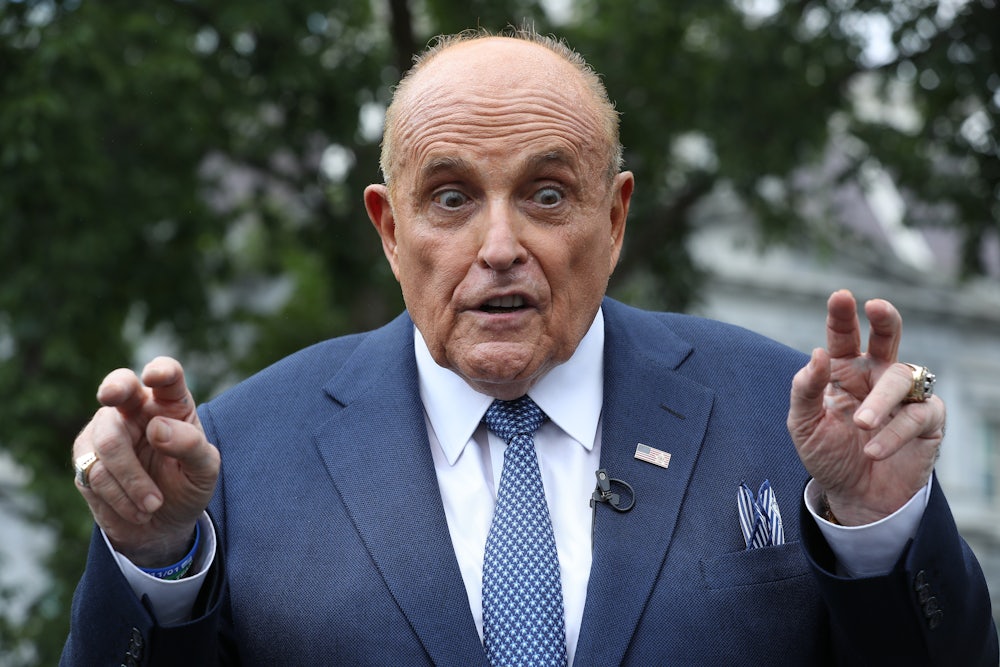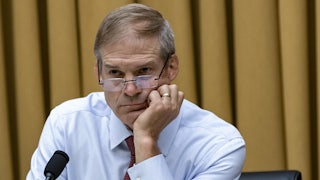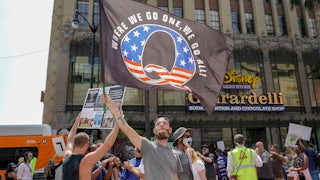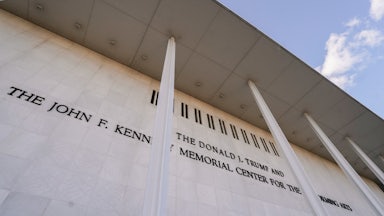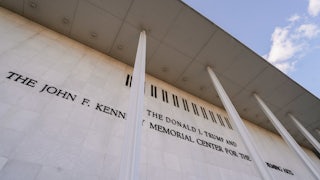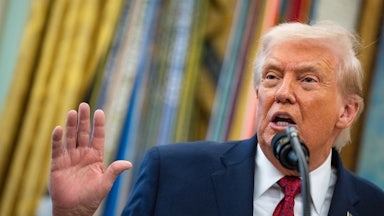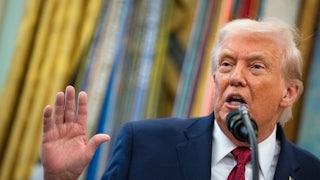Did you hear the one about Chinese Communists rigging Nest thermostats to fix the 2020 election? In video testimony made public last week, Trump White House lawyer Eric Herschmann told the January 6 select committee that former national security adviser Michael “23 Days” Flynn brought up this conspiracy theory at former President Donald Trump’s now-famous six-hour Oval Office meeting on December 18, 2020. Present at the meeting were Flynn, Sidney “Release the Kraken” Powell, former Overstock chief executive (and Maria Butina dupe) Patrick Byrne, former New York City mayor turned Bloody Mary fancier and Trump mouthpiece Rudy Giuliani, and assorted comparatively sane White House officials alarmed to learn that these misfits had been admitted entry. In a White House that one former inmate describes as “a clown car on fire running at full speed into a warehouse full of fireworks,” this meeting was a sort of climax, the most extraordinary White House gathering of paranoiacs since Richard Nixon dined alone. Tears were shed, screams emitted, insults hurled, blows very nearly exchanged. Posterity grieves that John Trumbull wasn’t on hand to paint it.
The apparent moment of peak insanity—the climax, if you will, of the climax—was Flynn’s disquisition on the Thermostat Menace. “At one point,” Herschmann said,
General Flynn took out a diagram that supposedly showed I.P. addresses all over the world, and who was communicating with whom, via the machines, and some comment about, like, Nest thermostats being hooked up to the internet.
(This is at 55:18 in the archived committee video.)
It wasn’t the last Trump would hear about Nestgate. That same month, according to Jonathan Karl’s 2021 book, Betrayal: The Final Act of the Trump Show, Pennsylvania Representative Scott Perry, a hard-core election conspiracist, put Trump in touch with an environmental lawyer named Jeffrey Clark who headed the Justice Department’s Environment and Natural Resources Division and was acting head of the Civil Division. Here’s a DOJ guy, Perry told Trump, who agrees with you that the election was stolen! Talk to him! Clark met with Trump shortly after the December 18 meeting. He promised Trump that he would press his superiors to investigate claims of voting fraud, including the ChiComs’ purported use of Google Nest thermostats, which Clark said were made in China, to manipulate Dominion voting machines in Georgia.
Meanwhile, Karl’s book reports, Trump ordered John Ratcliffe, his director of national intelligence, to investigate the alleged Nest treachery. According to CNN, it was chief of staff Mark Meadows who contacted Ratcliffe about the smart thermostats; maybe they both did. Meadows, CNN reported, urged the FBI, the Pentagon, and the National Security Council to investigate the thermostat allegations too.
Byrne, meanwhile, was spreading the gospel on right-wing social media that a
Chinese company in—well, I won’t tell you the city in China, [but] a company whose name is already at the periphery of some of this mischief—that they were accessing, through the internet, through a hidden port in a thermostat in the room, getting on the Dominion machine that was being used for vote counting in the middle of the vote counting in a swing state.
It’s easy to see why Flynn, Clark, Byrne, and, ultimately, Trump fell in love with this conspiracy theory. (Meadows, I presume, was just doing as Trump told him, per usual.) It implicated China, Silicon Valley, and Dominion—three of Trump’s favorite punching bags—and alleged irregularities in Georgia, the state Trump was working hardest to flip. That the allegations were about an everyday appliance lent them an air of spine-tingling intimacy. Mother of God! The calls are coming from inside the house! I have a Nest thermostat in my own home, and ever since last week’s hearing I’ve been wondering what mischief it gets up to when I’m out of town.
Before proceeding further, let me make absolutely clear that I consider the thermostat conspiracy theory to be wholly idiotic. I emphasize this because Dominion has sued Byrne for spreading all sorts of toxic conspiracy theories, including this one. Setting aside the thermostat narrative’s innate risibility, it withers when brought within 10 yards of the facts. The most salient of these is that any Nest thermostats that cross the Pacific to the United States aren’t even made in China, as Clark (and, I presume, Flynn) alleged to Trump. After Trump slapped a steep tariff on the devices, Google shifted all U.S.-bound production from China to Taiwan and Malaysia. That happened a year and a half before the 2020 election. So it would have to be Taiwan and Malaysia that tried to rig a U.S. election, and if you can suggest a possible motive for them to do so you have a richer imagination than I. (For a more comprehensive takedown of Trump’s many election conspiracy theories, I refer you to “Lost, Not Stolen,” a report released last week by a group of distinguished conservative leaders.)
The press in the U.S. has been awfully slow—much slower than the media-savvy January 6 committee—to recognize the comic possibilities in Nestgate. Apart from ABC News, where Karl works, and CNN, the smart-thermometer caper got scarcely any coverage at all. I attribute this to a laudable impulse not to spread disinformation ginned up by the far right. But some far-right fever dreams are too hilarious not to share with the news-consuming public. The British understand this better than we do. They’ve given the Thermostat Menace much wider play, presenting it in the appropriate get-a-load-of-this-rubbish spirit. It does, after all, read like the script of a political farce by the brilliant British satirist Armando Iannucci, creator of In the Loop, Veep, and The Death of Stalin.
But I digress.
After meeting with Trump, Clark went back to the Justice Department and drafted a letter urging Georgia officials to investigate allegations of voter fraud. Clark told his superiors, including acting Attorney General Jeffrey Rosen, that he hadn’t fact-checked the letter but that they should send it as soon as possible. They rejected his advice. In an accompanying email, dated December 28, Clark requested authorization to “get a classified briefing tomorrow from [the Office of the Director of National Intelligence] led by [Director of National Intelligence] Radcliffe [sic.] on foreign interference issues” so that “I can then assess” whether a national emergency ought to be declared. Clark noted that
white hat hackers have evidence (in the public domain) that a Dominion machine accessed the internet through a smart thermostat with a net connection trail leading back to China. ODNI may have additional classified evidence.
Rosen granted Clark’s request for a DNI briefing, CNN reported, in the misplaced hope that it would shut Clark up. At the briefing, Ratcliffe told Clark there was no evidence that any foreign country had flipped votes. Clark didn’t believe him.
After Rosen and the other top Justice Department officials blew Clark off, Clark put himself at Trump’s service. Trump told Clark he was installing him as attorney general and that Rosen was out. Clark conveyed this message to Rosen on January 3, prompting Rosen to meet with the top dozen officials at the Justice Department, who all agreed to resign if Trump went through with it. Rosen and Clark then met with Trump in what Karl describes as “a set up like an episode of The Apprentice,” the two Jeffreys sitting side by side in front of the Resolute desk, each making his case, in turn, to the chief executive. Also in attendance were Meadows, Herschmann, and White House counsel Pat Cipollone. Eventually Trump backed down, asking only that Rosen not fire Clark. Rosen said he didn’t have the power to do that because Clark was a presidential appointee.
Where did rumors of the Thermostat Menace originate? I don’t know, but if forced to hazard a guess, I’d look somewhere in the general vicinity of a certain Russell Ramsland. A onetime congressional candidate from Texas, Ramsland has a cybersecurity company, Allied Security Operations Group, or ASOG, that played a key role in spreading various rumors of election fraud, according to a May 2021 takeout in The Washington Post. The main reason to suspect Ramsland—and again, I have no proof—is that two weeks before the paranoiacs’ White House conclave, on December 3, Ramsland said in an interview,
There was a report yesterday, and we’re looking into it, but it looks like it’s gonna prove out to be correct that in Savannah, Georgia there is a remote—excuse me, a smart thermostat, in one of the tabulation rooms, that is talking to a tabulation server and reporting the votes back to China. And that was traced by a Microsoft engineer. And he brought it to our attention yesterday. So, um, that’s being monitored.
The Microsoft engineer was never identified, and maybe he brought his story to someone else before Ramsland. But if he did, I can’t find it. This is the earliest mention I know about smart thermostats and the Chinese.
Ramsland (who told the Post he had never spoken to Trump) is a piece of work. He is, for instance, on record saying the following: “George Soros [who was born in 1930] helped form the ‘Deep State’ in Nazi Germany in the 1930s along with George H.W. Bush’s father [Prescott Bush], the Muslim brotherhood, and ‘leftists.’” (At the risk of being pedantic: Soros is Jewish, the Nazi party was created 10 years before Soros was born, and Hitler came to power when Soros was 3.) Such talk was a little too hot even for the Trump White House. But Giuliani used Ramsland as an expert witness at postelection hearings in multiple states, and Ramsland and ASOG contributed affidavits to many more. Byrne funded much of Ramsland’s research as part of a team he hired, starting in August 2020, to “reverse-engineer” election rigging. Please note that Byrne’s efforts began three months before the election even took place. Byrne called his team the “Bad News Bears.”
According to the Post story, ASOG briefings for clients “had a clandestine air,” and one of the briefers, who would give out only a code name, referred to himself as “a white-hat hacker.” That’s the same phrase Clark used in his Justice Department memo to identify the source of the thermostat allegations. To be sure, “white-hat hacker” is a term commonly used in the tech world to describe an expert who probes for vulnerabilities on behalf of business clients. (Think Robert Redford in Sneakers.) So perhaps the Post’s white-hat hacker (possibly Joshua Meritt, an ASOG employee who went by the code name “Spider”) was a different person from Clark’s white-hat hacker. But Clark wasn’t a techie, he was an environmental lawyer. How many white-hat hackers did he likely cross paths with?
After Ramsland mentioned publicly on December 3 that the thermostat story “looks like it’s gonna prove out to be correct,” Byrne replied on Twitter that he’d seen evidence that he believed backed up Ramsland’s story. I won’t quote Byrne’s precise words because they’re at issue in the libel suit that Dominion brought against Byrne. The fact that Byrne’s confirmation is at issue in the lawsuit strongly suggests that Byrne cannot, in fact, confirm Ramsland’s story—which even Ramsland said, on December 3, he hadn’t yet confirmed.
Two weeks later, Byrne went to the White House with Flynn, Powell, and Giuliani, and Flynn flagged the Thermostat Menace to the president of the United States. The rest, as they say, is history.
